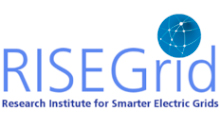
DACCOSIM NG in 4 questions
What type of code?
DACCOSIM NG is a practical environment to develop and run co-simulation use cases powered by JavaFMI (fmu-wrapper and fmu-builder), a suite of tools for...For whom?
Any industry needing to model and simulate complex 0D / 1D systems (large cyber-physical systems, multi-physical, multi-domain)What is it used for?
DACCOSIM NG can be used to simulate large systems.DACCOSIM NG is multi-language environment: it accepts as input any FMU component initially developed...
An example?
DACCOSIM NG is used to develop new methods of controlling complex system, such as energy systems combining electrical distribution network, heating network, sm...General information
DACCOSIM NG was developed by EDF and CentraleSupélec (France) within the RISEGrid institute (France) with the participation of SIANI (Spain), Monentia SL (Spain) and EIFER (Germany).






co-simulation made simpler
Links and downloading
Downloading:
- Software: https://bitbucket.org/simulage/daccosim/downloads
- Brochure: Distributed Architecture for Controlled CO-SIMulation New Generation for “co-simulation made simpler”
Tutoriels :
- [Vidéo] DACCOSIM NG: Tank-Barrel tutorial
- [Vidéo] DACCOSIM NG: from native model with OpenModelica to co-simulation with DNG
Last publication: DACCOSIM NG: co-simulation made simpler and faster
Further information: https://bitbucket.org/simulage/daccosim
Technical points
Development and simulation environment for complex systems by coupling components based on the Co-Simulation part of the FMI standard (fmi-standard.org).
Windows, Linux and any operating system using .jar files (Java).
Input: DACCOSIM NG uses any binary files exported as an FMU from FMI environments such as Dymola, OpenModelica, ControlBuild, Papyrus, etc.
Post-processing: DACCOSIM NG uses the OMPlot tool of the free OpenModelica suite to visualize the co-simulation results.
The Editor allows the design of co-simulation graphs using a graphical interface. The tool can also be run in batch (CLI) with a command script.
DACCOSIM NG is free software: you can redistribute it and/or modify it under the terms of the GNU Lesser General Public License as published by the Free Software Foundation, either version 3 of the License.
More detailed
DACCOSIM NG is a co-simulation environment (in the sense of the FMI standard) able to offer fixed or variable step numerical integration methods (Euler, Adams-Bashforth, QSS) which takes advantage of the main functionalities of the FMI-CS 2.0 standard (interpolation of inputs and outputs, error estimation, backtracking, ...). The tool also offers two co-initialization methods, one of which is based on the Newton-Raphson algorithm.
The developments are done in Java requiring a JRE version 8. The code implicitly exploits the software bricks of the JavaFMI suite (bitbucket.org/siani/javafmi) but the installation is very simple since only two .jar files need to be placed on the host machine. Moreover, there is an installer for Windows. It should also be noted that it is very easy to exchange complete co-simulation models between several machines with DACCOSIM NG thanks to a proprietary data exchange format.
The input data of the platform is a set of binary codes called FMU according to the FMI standard. Many modeling tools can now export an executable code of type FMU (Dymola, OpenModelica, ControlBuild, Papyrus, etc.). See the FMI site: https://fmi-standard.org/tools.
The results of a co-simulation with DACCOSIM NG are comparable to those that can be obtained from software such as Dymola or OpenModelica, but on a larger scale, easily exceeding one million algebraic-differential equations.


